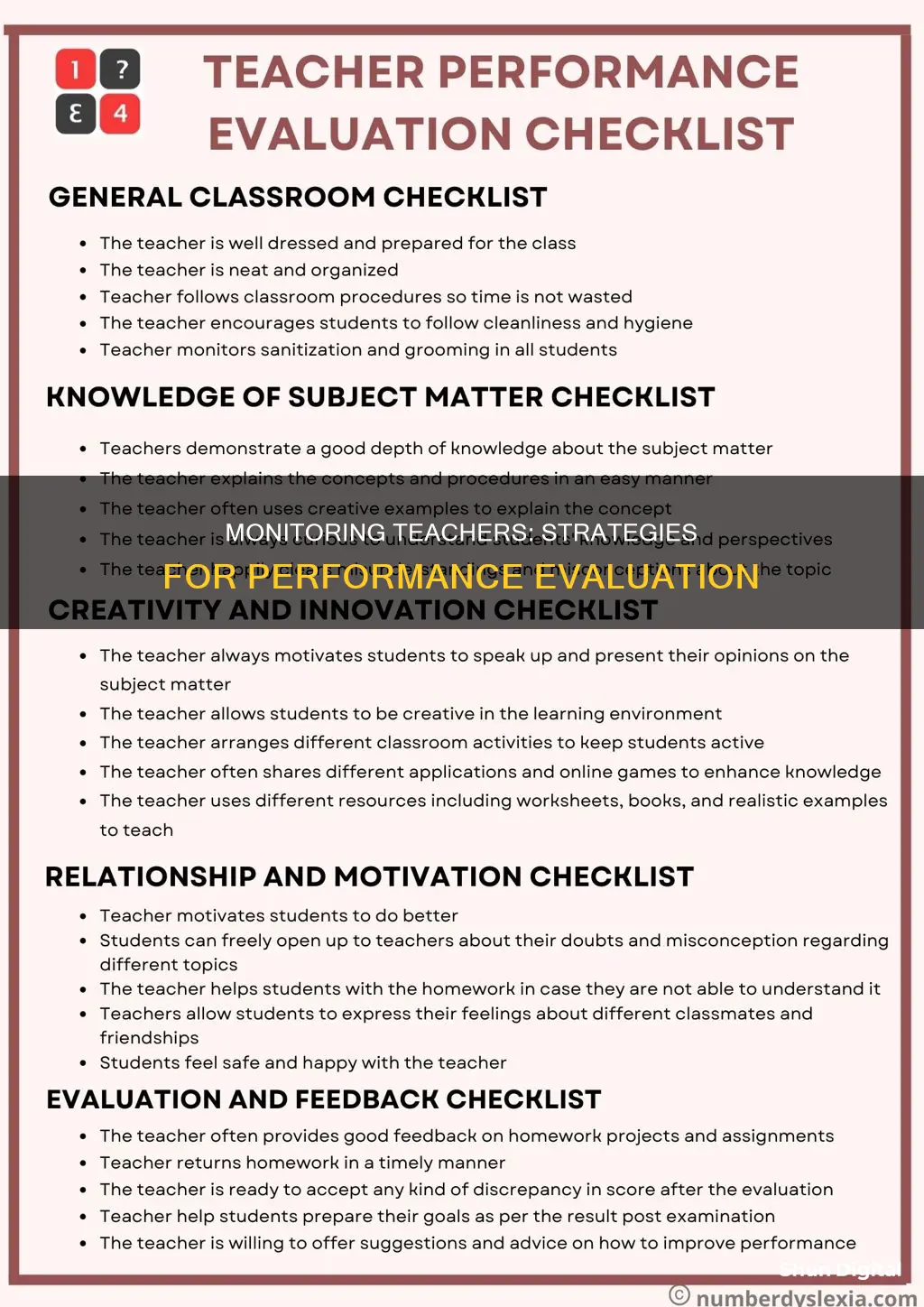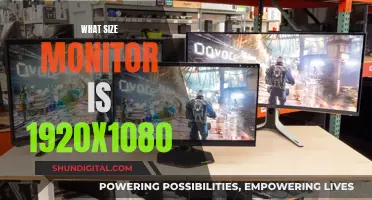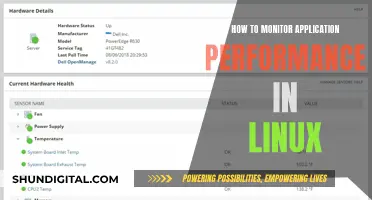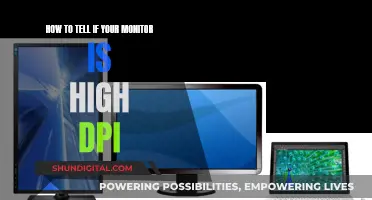
Monitoring teachers' performance is a critical aspect of ensuring quality education and fostering professional growth among educators. The process involves evaluating their teaching effectiveness, including their lesson planning, presentation, and ability to ensure student understanding. While traditional evaluations are often conducted by principals or department heads through classroom observations, they can be enhanced by incorporating a range of tools and methods. This includes the use of digital forms, peer feedback, student feedback, self-reflection, and the utilisation of photos and journals to track progress and encourage teacher development. Ultimately, the goal of teacher evaluation is to create a positive impact on both educators and their students, promoting a successful educational experience for all.
| Characteristics | Values |
|---|---|
| Lesson planning | Are lessons thoroughly prepared and do they have clear objectives? |
| Lesson presentation | Are lessons presented clearly and in an engaging manner? |
| Lesson follow-through | What tools are being used to check for understanding, and what are the outcomes of those assessments? |
| Student interaction | Are they fostering positive interactions with students? |
| Classroom environment | Are they creating a positive classroom environment? |
| Homework and assessments | Are they successfully using homework and assessments to determine student proficiency? |
| Communication | Are they communicating well with students, parents, and coworkers? |
| Teaching techniques | Are they integrating various teaching techniques to accommodate the unique needs of each student? |
| Student accommodation | Are they accommodating students with disabilities or behavioral challenges? |
| Cultural diversity | Are they integrating cultural diversity into the classroom curriculum? |
| Self-reflection | Are they regularly reflecting on their successes and failures, and the reasons behind them? |
| Student engagement | Are students actively participating and engaging in class? |
| Student outputs | Are students producing work that demonstrates their learning? |
What You'll Learn

Student-focused evaluation
Student Surveys and Feedback Forms:
One effective method is to distribute student feedback forms or conduct surveys. These forms can be tailored to different age groups and adapted to the specific context of the class and subjects taught. Students can provide anonymous feedback on various aspects of the teacher's performance, including teaching methods, classroom management, and their overall satisfaction with the course. This approach values students' voices and empowers them to reflect on their educational journey.
Academic Performance Analysis:
Analysing student academic performance can provide insights into the effectiveness of a teacher's instructional strategies. By evaluating student grades, test scores, and overall achievement, administrators can identify patterns or trends that may be linked to specific teaching practices. However, it is essential to consider other factors that may influence student performance, such as home environment, socio-economic status, and learning disabilities.
Student Interviews and Focus Groups:
Conducting individual or group interviews with students can offer qualitative data on their experiences with a particular teacher. Students can share their thoughts on the teacher's ability to create a positive learning environment, explain complex concepts, and adapt teaching methods to meet diverse learning needs. Interviews allow for more nuanced feedback and can provide context for understanding students' perceptions and experiences.
Student Portfolios and Work Samples:
Reviewing student portfolios or work samples can also be insightful. By examining student assignments, projects, and creative outputs, evaluators can assess the quality of teaching and the level of student engagement. This method provides tangible evidence of the knowledge and skills students have acquired and can help identify areas where the teacher excels or needs improvement.
Student Behavioural Observations:
Observing student behaviour in the classroom can provide valuable insights into the teacher's ability to manage the classroom and engage students. Evaluators can look for signs of active participation, collaboration, and positive interactions between students and the teacher. Additionally, observing student behaviour can help identify any issues or challenges that may impact their learning experience.
By implementing these student-focused evaluation strategies, administrators can gain a deeper understanding of the teacher's impact on students. This approach ensures that the ultimate beneficiaries of education—the students—are at the heart of the evaluation process, fostering a culture of continuous improvement and student-centred learning.
Ankle Monitors: Do They Shock or Not?
You may want to see also

Evaluating lesson preparation
Lesson preparation is a key aspect of a teacher's performance and can be evaluated through various methods. Here are some detailed guidelines for evaluating lesson preparation:
Self-Evaluation:
Teachers can regularly assess their lesson planning to identify areas for improvement and tweak their processes for enhanced efficiency and effectiveness. This involves reflecting on questions such as:
- How challenging was it to plan this lesson?
- Did I feel confident about the lesson's outcome?
- Were the resources and materials easy to find, or did I face time constraints?
- Was the lesson plan adaptable when unexpected changes occurred?
- Were the goals clear, suitable for the students' level, and achievable within the given time?
Student Feedback:
Students are a valuable source of evaluative information. Teachers can distribute questionnaires or conduct interviews to gather feedback on their teaching methods and students' comprehension. Additionally, observing students' behaviour, facial expressions, and body language during lessons can provide immediate feedback. Teachers can then modify their methods to suit the students' learning styles and ensure engagement.
Session Recording:
Audio and video recordings of classroom sessions can offer valuable insights into a teacher's actual teaching style, facial expressions, and interactions with students. Reviewing these recordings can help teachers identify areas for improvement and make necessary adjustments to their teaching approach.
Learners' Grades:
Students' performance in examinations and tests reflects their understanding of the material. If students are not achieving the intended goals, teachers should re-evaluate their teaching techniques to ensure they are employing the most effective methods for knowledge transfer.
Peer Evaluation:
Colleagues can provide valuable insights into teaching practices. They can visit classrooms, review syllabi, and offer suggestions for improvement based on their understanding of the student population and course content.
Journal Writing:
Encouraging teachers to maintain journals can be a powerful tool for self-reflection and evaluation. Writing about their teaching experiences and approaches allows teachers to identify areas for improvement and reflect on their strengths.
Photos and Videos:
Visual aids, such as photographs and videos, can be used to capture classroom moments and teaching practices. These can be compared over time to illustrate the teacher's progress and help them visualise the impact of their teaching methods on the students' learning experience.
By utilising these evaluation methods, educators can ensure that their lesson preparation is effective, engaging, and aligned with the students' needs, ultimately enhancing the overall teaching and learning experience.
Performance Monitor Analysis: A Step-by-Step Guide to Success
You may want to see also

Classroom observations
What to Observe
The evaluator should observe how students interact with the teacher during recitations and group discussions. They should note whether the teacher has created an active and fun learning atmosphere and how students react to this.
Beyond Observation
However, effective teacher evaluation should go beyond just observing the teacher. It should also involve seeing how students are learning and taking into account factors such as assessments, lesson plans, daily records, and student outputs.
Informal Observations
Informal observations can also be useful. These can include taking photos or videos of the classroom to capture moments of effective teaching or areas that need improvement. For example, capturing the teacher moving around the classroom and engaging with groups of learners can help illustrate a learner-centred approach. These visual tools can also help the teacher see their progress and boost their confidence.
Student Feedback
Student feedback is another important aspect of classroom observations. It can be a major motivating factor for teachers and provide insight into areas where students are struggling.
Self-Reflection
Encouraging teachers to reflect on their own teaching practices through self-evaluation is also beneficial. This can be facilitated through journals or self-reporting forms, where teachers can write about their daily routines, struggles, and successes. This helps educators realise their strengths and weaknesses and prepare for future promotions and accreditations.
ViewSonic Monitor Buying Guide: Where to Buy?
You may want to see also

Self-reflection and feedback
Self-reflection is an important aspect of teaching as it allows teachers to think critically about their teaching practices and identify areas for improvement. It is a process that involves collecting, recording, and analyzing various aspects of a lesson, such as the teacher's feelings, reactions, and observations about the students. This can be done through self-reflective journals, video recordings, student feedback, or peer observation.
One way to facilitate self-reflection is by keeping a self-reflective journal. Teachers can jot down their thoughts and feelings after each lesson, making notes on their reactions, feelings, and observations about their students. Breaking up the journal into sections such as lesson objectives, materials, classroom management, and students can help teachers stay organized and consistent in their self-reflections.
Video recordings of lessons can also provide teachers with an unbiased perspective on their teaching practices. This method is often used in colleges to teach aspiring teachers the value of self-reflection. Additionally, teachers can seek feedback from their students by distributing surveys or questionnaires. This not only provides valuable insights but also serves as an indirect writing exercise for the students.
Another way to gain feedback is through peer observation. Inviting a colleague to observe a lesson and provide feedback can be less intimidating than an evaluation by a principal or administrator. This creates a more relaxed environment, allowing the teacher to teach more naturally and receive honest feedback.
Self-reflection tools help teachers identify their strengths and weaknesses, ultimately improving their teaching practices and enhancing student learning. By taking the time to reflect, teachers can make the necessary adjustments to their instruction methods and create a more positive and effective learning environment for their students.
Practical Tips for Buying Parts to Fix Split Monitors
You may want to see also

Teacher-student interaction
Building a Positive Classroom Environment
A positive classroom environment is essential for effective teaching and learning. Teachers should strive to create an atmosphere where students feel safe, respected, and valued. This can be achieved by establishing clear rules and expectations, promoting a culture of kindness and inclusivity, and fostering a growth mindset that encourages students to take risks and learn from their mistakes.
Encouraging Active Student Engagement
Teachers should aim to make their lessons interactive and engaging. This can be done by incorporating a variety of teaching techniques, such as group work, discussions, and hands-on activities. By encouraging active participation, teachers can increase student motivation, promote critical thinking, and create a dynamic learning environment.
Individualized Attention and Support
Teachers should strive to give individualized attention to each student, recognizing that every student is unique and has different learning needs. They should be attentive to students' progress and challenges, offering extra support or enrichment as needed. This may involve differentiated instruction, one-on-one conferences, or small group work to ensure that all students can succeed.
Effective Communication and Feedback
Clear and open communication is vital for effective teacher-student interaction. Teachers should explain lessons and expectations clearly and be available to answer questions and provide feedback. They should also encourage students to share their thoughts, concerns, and ideas, creating a dialogue that enhances understanding and promotes a sense of respect.
Incorporating Student Feedback
Student feedback is an invaluable tool for improving teacher performance. Teachers can use formal or informal methods, such as surveys, conferences, or exit tickets, to gather student input on their teaching methods, lesson effectiveness, and areas for improvement. By involving students in the evaluation process, teachers can make informed decisions about their instructional practices.
Modeling Respect and Professionalism
Teachers set the tone for the classroom, and it is crucial that they model the behavior they expect from their students. This includes demonstrating respect, professionalism, and empathy in their interactions. By doing so, teachers can build positive relationships with their students, foster a sense of community, and create a safe space for learning and growth.
Monitoring Data Usage: Mediacom's Essential Guide
You may want to see also
Frequently asked questions
The key steps are: selecting the right evaluator, engaging teacher leaders, going beyond observation, reflecting with the teacher, and sharing best practices.
Aside from classroom observations, factors such as assessments, lesson plans, daily records, and student outputs should be considered.
Teacher evaluation aims to promote a better learning experience for students and foster professional growth for educators. It helps teachers align with the school's vision, engage in learning programs, upgrade skills, monitor student learning, and reflect on their practices.
Effective teacher evaluation provides educators with meaningful feedback and guidance to improve their teaching methods, fostering a positive impact on student learning.
Digital tools, such as structured forms and templates, can enhance the evaluation process by ensuring objectivity and providing actionable feedback. Additionally, photos and journals can be powerful tools for teacher development and self-reflection, helping educators measure their progress and identify areas for improvement.







